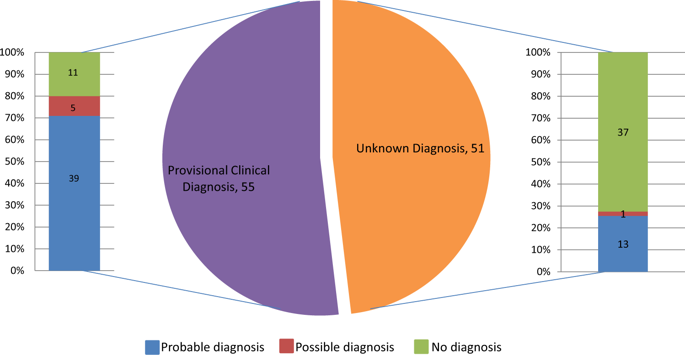当前位置:
X-MOL 学术
›
Eur. J. Hum. Genet.
›
论文详情
Our official English website, www.x-mol.net, welcomes your
feedback! (Note: you will need to create a separate account there.)
Diagnostic yield of panel-based genetic testing in syndromic inherited retinal disease.
European Journal of Human Genetics ( IF 3.7 ) Pub Date : 2019-12-13 , DOI: 10.1038/s41431-019-0548-5 Omamah A Jiman 1, 2 , Rachel L Taylor 1, 3 , Eva Lenassi 3 , Jill Clayton Smith 1, 3 , Sofia Douzgou 1, 3 , Jamie M Ellingford 1, 3 , Stephanie Barton 3 , Claire Hardcastle 3 , Tracy Fletcher 3 , Christopher Campbell 3 , Jane Ashworth 1, 4 , Susmito Biswas 4 , Simon C Ramsden 1, 3 , , Forbes D Manson 1 , Graeme C Black 1, 3
European Journal of Human Genetics ( IF 3.7 ) Pub Date : 2019-12-13 , DOI: 10.1038/s41431-019-0548-5 Omamah A Jiman 1, 2 , Rachel L Taylor 1, 3 , Eva Lenassi 3 , Jill Clayton Smith 1, 3 , Sofia Douzgou 1, 3 , Jamie M Ellingford 1, 3 , Stephanie Barton 3 , Claire Hardcastle 3 , Tracy Fletcher 3 , Christopher Campbell 3 , Jane Ashworth 1, 4 , Susmito Biswas 4 , Simon C Ramsden 1, 3 , , Forbes D Manson 1 , Graeme C Black 1, 3
Affiliation

|
Thirty percent of all inherited retinal disease (IRD) is accounted for by conditions with extra-ocular features. This study aimed to establish the genetic diagnostic pick-up rate for IRD patients with one or more extra-ocular features undergoing panel-based screening in a clinical setting. One hundred and six participants, tested on a gene panel which contained both isolated and syndromic IRD genes, were retrospectively ascertained from the Manchester Genomic Diagnostics Laboratory database spanning 6 years (2012-2017). Phenotypic features were extracted from the clinical notes and classified according to Human Phenotype Ontology; all identified genetic variants were interpreted in accordance to the American College of Medical Genetics and Genomics guidelines. Overall, 49% (n = 52) of patients received a probable genetic diagnosis. A further 6% (n = 6) had a single disease-associated variant in an autosomal recessive disease-relevant gene. Fifty-two percent (n = 55) of patients had a clinical diagnosis at the time of testing. Of these, 71% (n = 39) received a probable genetic diagnosis. By contrast, for those without a provisional clinical diagnosis (n = 51), only 25% (n = 13) received a probable genetic diagnosis. The clinical diagnosis of Usher (n = 33) and Bardet-Biedl syndrome (n = 10) was confirmed in 67% (n = 22) and 80% (n = 8), respectively. The testing diagnostic rate in patients with clinically diagnosed multisystemic IRD conditions was significantly higher than those without one (71% versus 25%; p value < 0.001). The lower pick-up rate in patients without a clinical diagnosis suggests that panel-based approaches are unlikely to be the most effective means of achieving a molecular diagnosis for this group. Here, we suggest that genome-wide approaches (whole exome or genome) are more appropriate.
中文翻译:

综合征性遗传性视网膜疾病中基于组合的基因检测的诊断率。
百分之三十的遗传性视网膜疾病 (IRD) 是由眼外特征引起的。本研究旨在确定具有一种或多种眼外特征的 IRD 患者在临床环境中接受基于组的筛查的基因诊断检出率。曼彻斯特基因组诊断实验室数据库跨越 6 年(2012-2017 年)对 106 名参与者进行了基因组测试,其中包含分离的 IRD 基因和综合征 IRD 基因。从临床记录中提取表型特征,并根据人类表型本体论进行分类;所有已识别的遗传变异均根据美国医学遗传学和基因组学学院指南进行解释。总体而言,49% (n = 52) 的患者接受了可能的基因诊断。另外 6% (n = 6) 的常染色体隐性遗传疾病相关基因中存在单一疾病相关变异。52% (n = 55) 的患者在测试时有临床诊断。其中,71% (n = 39) 接受了可能的基因诊断。相比之下,对于那些没有临时临床诊断的人 (n = 51),只有 25% (n = 13) 接受了可能的基因诊断。Usher (n = 33) 和 Bardet-Biedl 综合征 (n = 10) 的临床诊断确诊率分别为 67% (n = 22) 和 80% (n = 8)。临床诊断患有多系统 IRD 疾病的患者的测试诊断率显着高于没有多系统 IRD 疾病的患者(71% 对比 25%;p 值 < 0.001)。未经临床诊断的患者的检出率较低,这表明基于小组的方法不太可能成为该群体实现分子诊断的最有效方法。在这里,我们建议全基因组方法(整个外显子组或基因组)更合适。
更新日期:2019-12-13
中文翻译:

综合征性遗传性视网膜疾病中基于组合的基因检测的诊断率。
百分之三十的遗传性视网膜疾病 (IRD) 是由眼外特征引起的。本研究旨在确定具有一种或多种眼外特征的 IRD 患者在临床环境中接受基于组的筛查的基因诊断检出率。曼彻斯特基因组诊断实验室数据库跨越 6 年(2012-2017 年)对 106 名参与者进行了基因组测试,其中包含分离的 IRD 基因和综合征 IRD 基因。从临床记录中提取表型特征,并根据人类表型本体论进行分类;所有已识别的遗传变异均根据美国医学遗传学和基因组学学院指南进行解释。总体而言,49% (n = 52) 的患者接受了可能的基因诊断。另外 6% (n = 6) 的常染色体隐性遗传疾病相关基因中存在单一疾病相关变异。52% (n = 55) 的患者在测试时有临床诊断。其中,71% (n = 39) 接受了可能的基因诊断。相比之下,对于那些没有临时临床诊断的人 (n = 51),只有 25% (n = 13) 接受了可能的基因诊断。Usher (n = 33) 和 Bardet-Biedl 综合征 (n = 10) 的临床诊断确诊率分别为 67% (n = 22) 和 80% (n = 8)。临床诊断患有多系统 IRD 疾病的患者的测试诊断率显着高于没有多系统 IRD 疾病的患者(71% 对比 25%;p 值 < 0.001)。未经临床诊断的患者的检出率较低,这表明基于小组的方法不太可能成为该群体实现分子诊断的最有效方法。在这里,我们建议全基因组方法(整个外显子组或基因组)更合适。











































 京公网安备 11010802027423号
京公网安备 11010802027423号